Improve Your Driving Experience with a Trusted Tachometer
Improve Your Driving Experience with a Trusted Tachometer
Blog Article
The Value of a Tachometer in Checking Engine Speed and Efficiency in Automotive Applications
In the realm of auto design, the tachometer stands as a crucial tool in the driver's toolbox, supplying a straight window into the internal workings of a vehicle's engine. Beyond its function as a mere gauge of revolutions per minute (RPM), the tachometer offers as an essential device for enthusiasts and specialists alike, using real-time understandings into engine efficiency and health and wellness. Recognizing the significance of this tool exceeds surface-level monitorings, delving into the elaborate relationship in between engine speed, power result, and total driving experience. As we explore the multifaceted function of the tachometer in auto applications, a much deeper appreciation for its effect on car dynamics and effectiveness begins to emerge.
Significance of Checking Engine RPM
Keeping an eye on engine RPM, or revolutions per minute, is a critical aspect of vehicle upkeep and efficiency analysis. Engine RPM directly correlates with the rate at which the engine's crankshaft revolves, suggesting just how promptly the engine is running.
Furthermore, monitoring engine RPM is crucial for efficiency analysis in auto racing and high-performance vehicles. Preserving optimal RPM levels is essential for attaining peak power outcome and velocity. Racers commonly make use of tachometers to guarantee they are operating within the excellent RPM variety for maximum efficiency. In recap, keeping an eye on engine RPM is not only essential for identifying issues yet additionally for maximizing engine efficiency in different automotive applications.

Advantages of Real-Time Information
In automobile applications, real-time information plays an essential function in offering instant insights into the performance and condition of the lorry. By constantly keeping track of various specifications such as engine speed, temperature level, gas consumption, and much more, real-time data supplies many benefits that add to boosted performance and security when traveling.
One substantial benefit of real-time information is its capability to alert drivers and specialists to any kind of abnormalities or problems promptly. This proactive approach makes it possible for quick identification of possible issues, enabling timely treatments to avoid additional damages or failures. In addition, real-time information helps with performance optimization by offering prompt comments on driving behaviors and engine effectiveness. Motorists can readjust their behavior in real-time based upon this details to attain much better gas economic situation and lengthen the lifespan of their automobile.

In addition, real-time information plays an important duty in contemporary vehicle diagnostics, allowing professionals to promptly diagnose and deal with malfunctions. This causes decreased downtime, lower upkeep prices, and inevitably, improved overall automobile reliability and durability (tachometer). By using the power of real-time information, automotive stakeholders can make enlightened choices that positively influence both the performance and durability of the automobile
Effect On Gear Shifts
The tachometer plays an essential duty in maximizing equipment shifts by supplying real-time engine speed data to the vehicle driver. When useful content approaching the redline on the tachometer, it signifies the vehicle driver to upshift to protect against over-revving the engine and triggering possible damages.
Additionally, the tachometer aids in achieving smoother gear transitions, particularly in manual transmissions. By checking engine rate, vehicle drivers can implement equipment changes at the optimum RPM range, reducing jerking motions and reducing endure the transmission parts. This accuracy in equipment modifications not just enhances driving convenience yet additionally adds to fuel efficiency.
Enhancing Gas Performance
Offered the important function the tachometer plays in maximizing gear shifts for efficiency and engine health, it directly adds to making the most of fuel performance in automotive applications. By supplying real-time comments on engine speed, the tachometer aids drivers in maintaining the most efficient RPM array for fuel economic climate. When motorists consistently keep an eye on the tachometer and change their driving habits as necessary, they can avoid unnecessary fuel usage brought on by over-revving or carrying the engine.
In addition, the tachometer helps drivers recognize the most fuel-efficient check over here gear to be in at any type of given moment, stopping the engine from working tougher than needed. This is particularly click resources vital during acceleration and cruising, where remaining in the appropriate gear can dramatically impact fuel efficiency. Additionally, the tachometer can alert drivers to potential mechanical problems that could be adversely affecting gas economy, such as a slipping clutch or a clogged air filter. Finally, the tachometer works as a beneficial device in improving gas effectiveness by promoting optimum driving behaviors and recognizing locations for enhancement in the car's performance.

Making Best Use Of Engine Long Life
The tachometer's duty in keeping track of engine speed and performance is critical in making sure the durability of auto engines. Checking the tachometer permits drivers to stay within the recommended RPM range for their automobile, stopping unnecessary stress on the engine and expanding its lifespan.

Conclusion
Finally, the tachometer plays a crucial function in keeping an eye on engine speed and performance in vehicle applications. By supplying real-time data on RPM, it permits reliable gear changes, improved fuel effectiveness, and made the most of engine long life. This device is vital for preserving ideal engine performance and ensuring the general performance of a lorry.
Report this page